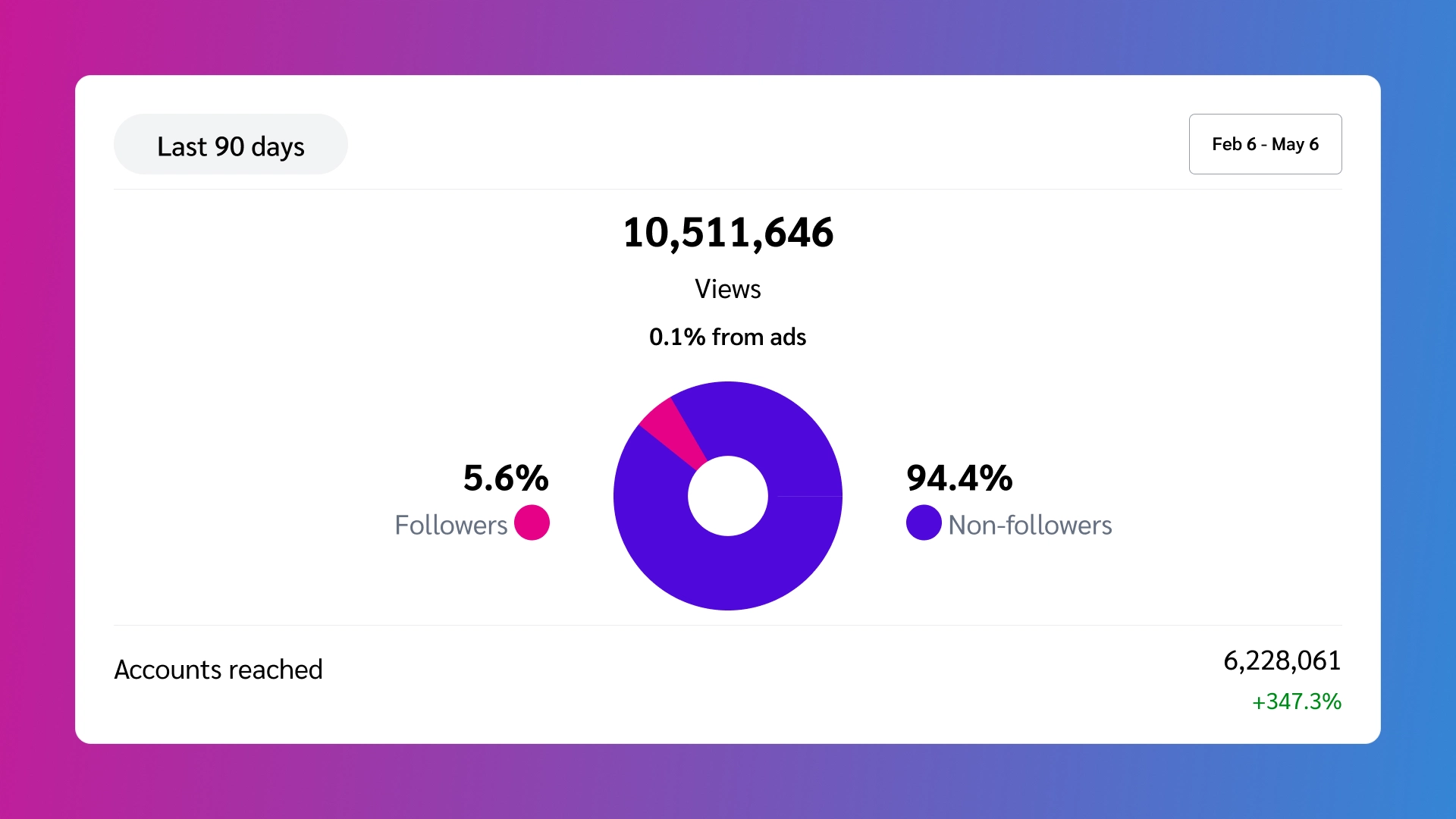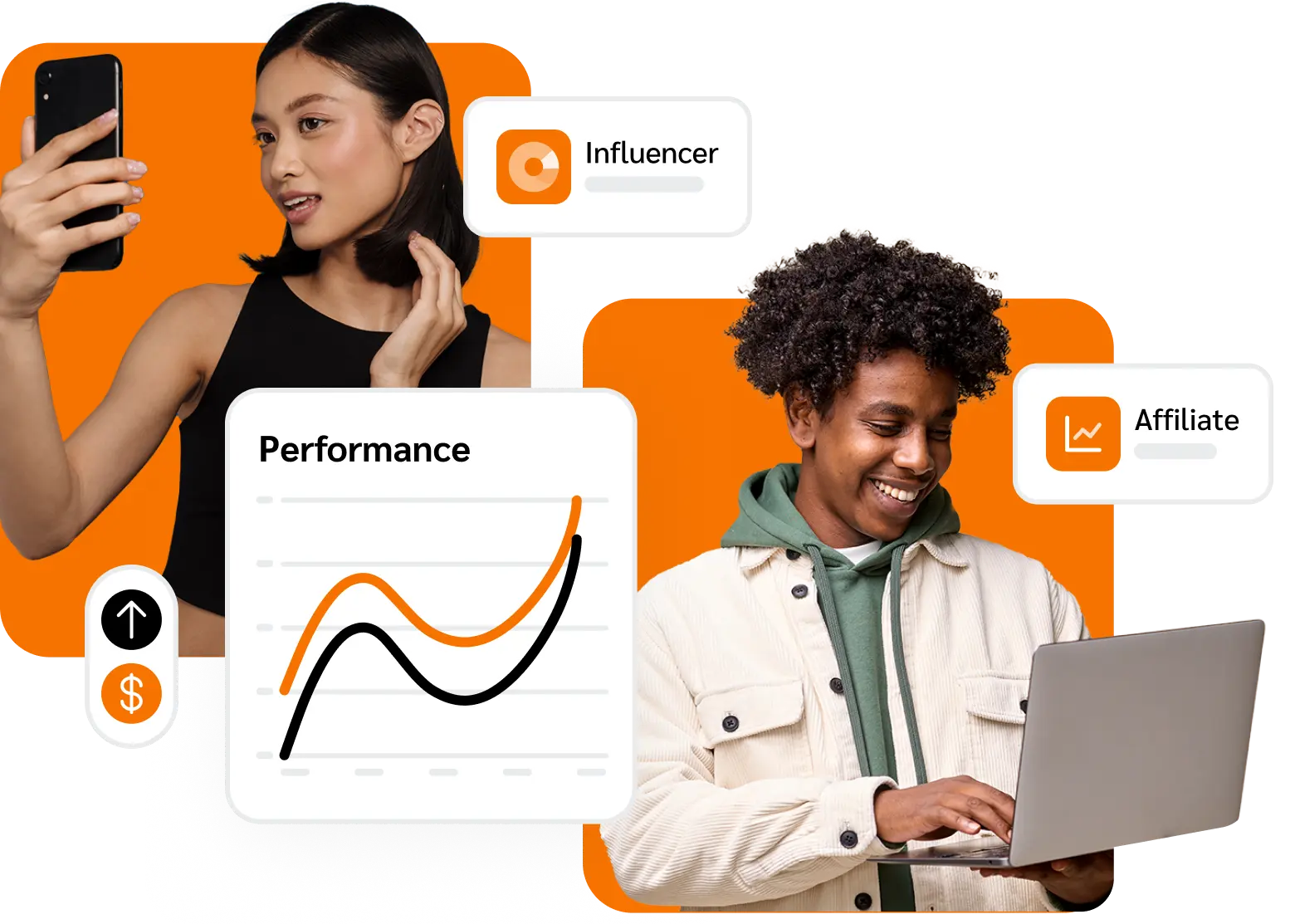At iPX 2025 in Austin, Texas, Jeff Melton dropped a statistic that stopped marketers in their tracks. The Senior Director of Global Creator Community and Consulting at impact.com was about to prove that everything we knew about creator compensation was wrong.
“Roughly 94 percent of a creator’s 10.5M views over 90 days came from non-followers—proof that in the age of algorithmic discovery, content quality beats audience size,” said Melton.

These results underscore a key change: Platforms now reward engaging content over existing audience size. The algorithm surfaces what performs, regardless of who made it or how many followers the creator has—reshaping influence from something owned to something earned in real time.
Today, creators no longer need massive followings to drive impact. They need content that resonates, performs, and plays to the platform’s discovery engine.
With the creator economy now valued at over $33 billion—more than triple its size since 2019—and only 2 percent of consumers considering traditional ads as credible sources for product discovery, the stakes for getting creator compensation right have never been higher.
During a panel discussion, industry leaders revealed why follower-based payment methods are becoming obsolete and what smart brands are doing instead.
Jeff explaining the three A’s and showing the Instagram analytics slide
The conversation, featuring influencer talent manager Johanna Voss, Verbatim agency founder Brianna Doe, and DMI Partners executive Kristina Nolan, tackled the uncomfortable truth:
Everything we thought we knew about how to pay influencers and content creators needs to change.
Melton explained, highlighting three massive shifts—algorithmic delivery, affiliate integration, and ambassadorships—that are forcing brands to completely reimagine creator compensation strategies.
Why traditional influencer payment models are broken
The follower count pricing fallacy is officially dead
Melton’s data point exposed the fundamental disconnect between how brands price creator partnerships and how content actually performs. If over 90 percent of a creator’s views come from non-followers, traditional rate cards based on audience size and audience composition are pricing the wrong metric entirely.
The content graph revolution
Platforms like TikTok, Instagram Reels, and YouTube Shorts have ushered in the era of the “content graph”—where algorithms prioritize content quality and engagement over follower relationships. This shift means:
- Nano-influencers can reach millions through viral content
- Mega-influencers may struggle to achieve significant organic reach of their followers
- Content quality and algorithm compatibility trump audience size
Nano foodie influencer @delightfuleats thrives in her niche, showcasing the trendiest restaurants and cafes.
The content creator-affiliate convergence
The iPX panel highlighted another thing that’s been quietly reshaping partnerships: the lines between influencer and affiliate marketing are completely blurring. Content creators increasingly function as both content producers and performance marketers, while brands seek measurable results alongside creative content.
This convergence isn’t just theory—it’s delivering measurable results. Internal data from impact.com shows that brands partnering with affiliates and influencers generate 46 percent higher affiliate-based sales than brands working with affiliates alone. For categories like health and beauty, this performance boost increases to 178 percent.
This convergence is creating new, hybrid compensation models that blend upfront payments with performance incentives. It requires both brands and content creators to navigate more sophisticated partnership structures that account for both creative and conversion value.
How much should you pay content creators in 2025?
The evolution from 2018 to 2025 tells a story of dramatically increasing complexity in influencer compensation. As Voss explained during the panel, “It used to be just like, okay, deliverables, rate, much more transactional, a la carte. And now there’s so many more cooks in the kitchen on the brand side.”
Johanna explains the evolution of the partnerships from 2018 to 2025
The complexity explosion
What used to be a straightforward negotiation—creator rate plus deliverables—has evolved into multi-layered discussions involving:
Usage rights and exclusivity: Modern partnerships must address organic usage, paid promotion, whitelisting, dark post advertising, and content repurposing rights from the outset.
Cross-platform requirements: Single partnerships now often span Instagram, TikTok, YouTube, and sometimes traditional media, each with different performance expectations and usage rights considerations.
Production considerations: Content complexity varies dramatically. “DIY home project creators is a lot more involved than a food creator than a fashion person who’s showing the outfit of the day,” Voss noted, highlighting how creation effort affects pricing.
Behind every quality piece of content, like @paintyourlifestyl‘s travel videos, lies considerable effort and artistry.
Content value and repurposing rights: User-generated content from content creators delivers significant cost advantages. Brands leveraging authentically created UGC see customer acquisition costs 20 to 30 percent lower than those using solely brand-generated assets. This makes usage rights discussions increasingly critical to compensation negotiations.
Content creator business overhead reality
The professionalization of content creation has introduced new cost considerations that brands often overlook. Many successful content creators now operate with full teams including managers, editors, and photographers.
“By the time they pay out their manager, their team, their editor, their photographer, they’re like, hey, I’m left with $800,” Voss shared, illustrating how overhead impacts pricing negotiations.
Market flexibility in 2025
Economic realities have made pricing more fluid than ever. “Rates are kind of made up,” Voss candidly admitted. “They are what the market can potentially bear, and the market is drastically changing.”
This flexibility extends beyond rates to entire partnership structures. Current economic pressures have made content creators more open to varied compensation models as “work begets work” in an increasingly competitive landscape.
“There’s so many more factors that go into it that I don’t think you can have. It isn’t just that simple. One plus one equals two anymore,” Voss emphasized, capturing the complexity that modern partnerships require.
Your competitive edge: payment terms as strategy
While most brands focus solely on rates, the iPX panel revealed that payment speed has become a powerful differentiator and negotiation tool.
The payment speed reality check
The panel didn’t hold back when discussing payment timelines:
Less than Net 30: Can yield lower rates
Net 30: Respectful and industry-appropriate
Net 45: Acceptable for major brands with complex processes
Net 90+: Relationship killers that damage brand reputation
“Net 90, yikes. Net 180, I’ve heard that one,” said Doe, emphasizing how extended payment terms can poison content creator relationships.
Research by impact.com and EMARKETER reveals that 33 percent of consumers ‘appreciate transparency but evaluate products independently,’ while 34 percent want ‘more authentic reviews, including negative ones.’
This data supports performance-based compensation models—creators who can provide honest, nuanced reviews (even with some criticism) often drive higher conversion rates than those delivering only positive messaging.
Authenticity shines in reviews like @heykeeya’s Astrabody UK experience, fostering trust with audiences.
Content creator payment terms that win partnerships
Progressive brands are discovering that faster payments provide genuine competitive advantages in influencer marketing. “We’ve seen creators being more willing to potentially discount some of their rates for much quicker payment,” Nolan revealed during the session.
The panel discusses payment terms and creator discounting
Effective influencer payment strategies include:
- Upfront flat fee payments for immediate cash flow relief
- Five-day post-delivery payments that exceed expectations
- 50 percent upfront, 50 percent on completion splits
The partnership mindset
Payment terms reflect more than financial processes—they demonstrate respect and partnership values. “It’s a partnership,” Doe emphasized. “Respecting the content creators that you’re working with, the time and energy they put into creating the content for your brand. I think compensating them fairly and quickly is the least you can do.”
Navigating operational complexity
The panel acknowledged the reality many brands face with complex approval processes. As Voss explained, payment delays often involve multiple stakeholders, third-party vendors, and international processing systems.
Her practical advice: “Stay on it, know your due dates, follow up, friendly reminder. Do not ever get mean or angry because even if it’s not their fault, they’re going to remember that about you and it could cost you future partnerships.”
The data-driven creator pitch that actually works
During the Q&A portion of the iPX session, an audience member asked how content creators can most effectively pitch themselves to brands. The panel’s insights were immediately actionable.
The proof-of-concept approach
Voss’s strategy centers on organic content evidence:
This approach works because it provides concrete performance data rather than theoretical projections. Successful pitches include:
- Screenshots of organic brand mentions and engagement
- Performance metrics from similar content. (This requires asking the brand for private performance metrics or gathering what’s available from affiliate performance and adding it to a media kit)
- Audience feedback and comments demonstrating brand affinity
- Examples of natural product integration
Speaking the brand’s language
Doe added crucial context for content creator pitches: “Treat the marketer or the brand like they’re your customer. Understanding what they’re trying to solve for, what pain points they’re feeling… is crucial.”
The key insight: don’t just present metrics. Understand brand goals first, then demonstrate how your content can achieve those specific objectives. For example, as a creator, explain how your content for performance differs from top-of-funnel storytelling.
Nolan reinforced this approach:
Best practices for paying influencers and content creators
Based on the insights shared at iPX 2025, here’s how forward-thinking brands are adapting their content creator payment strategies:
Immediate changes to implement
Audit your payment processes
Review standard timelines and identify opportunities to accelerate payments. Even reducing from Net 45 to Net 30 can improve creator relationships and potentially reduce rates.
Rethink rate card structures
Move beyond follower-count-based pricing toward metrics that reflect actual performance potential, content quality, and brand alignment.
Segment creators based on their performance
As you sunset legacy, follower-based payment models, segment creators based on their performance instead to retain top performers by increasing their rates.
Coach creators to optimize performance
With so many creators being new to performance strategies, host recurring workshops and together with the creators watch the content that performed best so they can observe and adopt what works.
Framework for modern partnerships
The most successful brands treat creator partnerships as business relationships, rather than media transactions. This approach includes:
Performance-focused metrics: Prioritizing historical performance, performance potential, and brand alignment over vanity metrics like follower count.
Comprehensive scope discussions: Addressing all deliverables, usage rights, exclusivity periods, and performance expectations before final contracts.
Payment terms as differentiation: Using faster payment schedules and flexible terms to stand out from competitors.
Long-term relationship building: Developing ongoing, community-centric partnerships (focusing on retaining top-performers) that benefit both parties rather than one-off campaign transactions.
@lifewithkleekai has built a vibrant community of pet lovers, making them ideal partners for dog-food brands. Video source.
Critical questions for every partnership
Before entering creator partnerships, answer these essential questions:
- What are our actual KPIs for this campaign beyond vanity metrics?
- What usage rights do we need, and how should they affect compensation?
- How can we use payment terms and partnership structure as competitive advantages?
- Are we approaching this as a true business partnership, complete with coaching, or just a media placement?
Platform-specific payment strategies: Matching compensation to distribution reality
As algorithmic delivery reshapes content distribution, creator compensation strategies must adapt accordingly. A creator’s primary content distribution method should directly influence payment structure, moving beyond one-size-fits-all rate cards.
Creator-driven purchase journeys are increasingly complex, demanding sophisticated attribution methods. Data by impact.com and EMARKETER shows multiple purchase paths:
- 56 percent buy directly via platform shopping features
- 41 percent use links to brand/retailer sites
- 32 percent search on marketplaces like Amazon
- 17 percent make purchases later during promotional periods
This multi-touchpoint reality requires tracking systems that capture value across the entire customer journey, not just immediate clicks.
Algorithm-based platforms rely on performance
Traditional follower-based pricing breaks down on algorithm-driven platforms like TikTok, Instagram Reels, and YouTube Shorts. On these platforms, a nano-creator can achieve massive reach while a macro-influencer might struggle for visibility.
Compensation should reflect performance potential, not audience size.
Recommended approach:
- Lower base rates with higher performance bonuses tied to views, engagement, and conversions
- Rapid testing cycles with multiple content variations to identify algorithmic winners
- Performance data sharing to help creators optimize for platform algorithms
- Flexible campaign budgets that can scale up successful content in real-time
Follower-based platforms are built on relationships
Creators who excel on follower-based platforms like newsletters, podcasts, YouTube long-form content, and LinkedIn articles have built direct audience relationships that provide more predictable reach. This reliability justifies different compensation structures.
The Nightclubs to Night Feeds podcast, co-hosted by @withnicolegarcia, is a standout example of a platform thriving on audience relationships.
Recommended approach:
- Higher guaranteed base rates reflecting the predictable audience access
- Long-term partnership terms that leverage the creator’s established audience trust
- Cross-platform integration opportunities, as these creators often have strong personal brands
- Audience insights sharing to maximize the value of the direct relationship
Hybrid creators: Flexible portfolio pricing
Many successful creators operate across both distribution types, requiring sophisticated compensation models that account for their diverse content ecosystem.
Strategic considerations:
- Platform-specific rate cards that adjust based on where content will be published
- Content format bonuses for creators who can adapt the same campaign across multiple platform types
- Performance tracking by platform to identify each creator’s strongest channels
- Budget allocation flexibility to emphasize the platforms where individual creators perform best
Implementation framework
When structuring platform-specific compensation:
- Audit creator content distribution across their portfolio to understand their algorithmic vs. follower-based content mix
- Set baseline expectations for each platform type based on historical performance data
- Create flexible agreements that can adjust compensation based on actual platform performance
- Establish clear attribution methods for tracking results across different distribution types
Through engaging tutorials, @financewithcamacho encourages his audience to click affiliate links, making it easy to track actions such as opening accounts or downloading finance apps.
This platform-aware approach means brands pay for actual influence potential rather than outdated metrics. It also gives creators incentives to optimize content for their strongest distribution channels.
Building sustainable creator ecosystems
The most successful brands are treating creator partnerships as business relationships with shared goals rather than media placements to be managed—and they’re structuring these relationships through tiered community models that deliver compounding results.
From campaigns to communities: The tiered approach
Based on an internal study conducted by impact.com, we discovered that sustainable creator success follows a power-law distribution where a small percentage of top-performing creators account for the majority of revenue.
However, building this high-performing cohort requires sustained investment—typically 8-12 months of continuous posting and coaching cycles.
The solution is a structured tiered community approach that leading brands have begun implementing:
Entry-level creators represent the largest group by volume but contribute a smaller percentage of total revenue. These partners receive baseline compensation plus starter commission rates, along with access to best-practice playbooks and brand guidelines.
Mid-tier loyalists make up a smaller percentage of creators while driving proportionally higher revenue. These established partners earn higher rates, gain access to exclusive products and storefronts, receive bonuses when content is repurposed, and enjoy priority communication.
Top-tier champions represent the smallest group but generate the majority of revenue. These creators receive the highest compensation rates, early product access, priority placement in major campaigns, and revenue-sharing opportunities for mentoring other creators.
The coaching multiplier effect
Continuous coaching transforms this tiered structure from a traditional affiliate program into a performance engine. Brands that house their own performance data—rather than outsourcing to platforms like LTK—can provide personalized guidance on creative hooks, content formats, call-to-action optimization, and linking best practices.
This coaching approach converts “brand storytellers” into conversion creators, leveraging the algorithmic meritocracy where any motivated creator can sell if given the right guidance and playbook. The impact.com and EMARKETER research supports this approach: consumers need to see creators promote products 3-4 times on average before purchasing, making sustained relationships more valuable than one-off campaigns.
Payment innovation as community enabler
The payment strategies discussed earlier—faster terms, transparent processes, performance bonuses—become essential enablers of this community model. Champions earning revenue sharing need reliable payment systems.
Entry-level creators progressing to loyalists require clear advancement criteria and prompt compensation adjustments. As mentioned previously, The 46 percent performance boost that brands achieve when integrating affiliate and influencer strategies becomes sustainable only through systematic relationship management.
Implementation framework for community-based partnerships
Successful modern partnerships within this tiered approach include:
Performance-focused advancement: Clear metrics for tier progression based on engagement rates, conversion potential, brand alignment, and content consistency rather than follower count alone.
Comprehensive value exchange: Base compensation plus performance incentives, exclusive access and experiences, content usage rights clearly defined upfront, and non-monetary benefits like networking and skill development.
Data-driven personalization: Owned performance analytics to customize coaching, platform-specific guidance based on creator strengths, and transparent reporting on campaign results and tier progression.
Long-term relationship building: Multi-month partnerships that allow for sustained exposure, collaborative content planning that leverages creator expertise, and shared investment in creator success through training and resources.
Critical questions for community-based partnerships
Before implementing a tiered creator community, answer these questions:
- What are our actual KPIs for this program beyond vanity metrics, and how do they map to tier advancement?
- How will we provide personalized coaching and support at scale across different creator tiers?
- What usage rights and exclusive benefits can we offer at each tier to justify different compensation levels?
- Do we have the internal infrastructure to house creator performance data and provide actionable insights?
- How will we balance tier advancement criteria to maintain motivation while ensuring quality standards?
This community-focused approach transforms creator partnerships from transactional campaigns into strategic business relationships. These relationships compound value over time and set the foundation for sustained performance in the algorithmic economy.
Frequently asked questions about content creator compensation
The most effective creator payment methods combine guaranteed compensation with performance incentives. Hybrid models that include base rates plus commissions perform best, with faster payment terms (Net 30 or quicker) often allowing brands to negotiate better rates and stronger partnerships.
Successful influencer rate negotiations focus on value delivery rather than follower counts. Brands should consider usage rights, cross-platform requirements, content complexity, and creator overhead when determining fair compensation. Payment speed and partnership terms often matter more than base rates.
Modern influencer pricing depends on content quality, engagement rates, platform performance, usage rights, exclusivity requirements, and production complexity. Creator business overhead including teams, editors, and managers also impacts pricing discussions significantly.
Payment timing has become a key negotiation tool. Many creators will discount rates for upfront payments or quick post-delivery payments (5 days). Split payments (50 percent upfront, 50 percent on completion) balance cash flow needs for both parties effectively.
Performance-based creator compensation typically combines base rates with bonuses tied to specific metrics like engagement rates, conversions, or sales. This hybrid approach provides creator security while motivating exceptional results and aligning goals between brands and creators.
The lines between influencer and affiliate compensation are blurring rapidly. Modern creator partnerships often include both content creation fees and performance commissions, allowing creators to earn from both audience access and sales generation.
Industry best practices suggest Net 30 payment terms as respectful and appropriate. Net 45 is acceptable for large brands with complex processes, but anything longer than Net 60 risks damaging creator relationships and brand reputation in the creator community.
Content creator compensation is determined by multiple factors beyond follower count, including algorithmic performance potential, content quality and production complexity, usage rights and exclusivity requirements, cross-platform distribution needs, and creator business overhead costs. Since algorithmic delivery means creators with 100,000 followers may only reach 5 percent of their audience, brands now focus on engagement rates, content resonance, and performance history rather than audience size alone.
The biggest payment mistakes that damage brand-creator relationships include extended payment terms beyond Net 90, failing to discuss usage rights upfront, underestimating creator business costs and overhead, treating creators as media vendors rather than business partners, and lacking transparency about approval processes and payment timelines. These mistakes often result in negative word-of-mouth that spreads quickly through creator networks, limiting future partnership opportunities.
The algorithmic advantage
Algorithmic delivery has made follower count irrelevant. In this environment, brands building creator communities have a decisive advantage.
They can identify and develop high-performing creators regardless of audience size, or provide coaching and support that turns nano-creators into conversion specialists. And they maintain the long-term relationships that algorithms reward through consistent, authentic content.
As Johanna Voss noted at iPX, “If you are someone who isn’t flexible and understanding that there’s just a lot more flexibility that goes into pricing and doing projects at least now for where we’re at in 2025,” adaptability isn’t optional—it’s the foundation of competitive advantage.
Your next steps
The brands implementing these insights immediately are moving beyond transactional campaigns toward strategic creator ecosystems that deliver compounding returns.
Start with payment fundamentals: Audit your current payment processes, implement faster terms, and establish performance-based compensation structures that reflect algorithmic realities rather than outdated follower metrics.
Build toward community: Use improved payment relationships as the foundation for tiered creator partnerships that provide sustained value for both brands and creators through coaching, progression paths, and shared success metrics.
Measure what matters: Focus on conversion potential, content consistency, and brand alignment rather than vanity metrics, using owned data to personalize relationships and optimize performance over time.
For brands ready to implement specific payment methods within this new framework, explore our comprehensive guide to the 7 most popular creator compensation models and discover which tactical approaches work best for different partnership goals.
Keep the conversation going—explore our additional insights and resources to stay ahead.
- How to pay content creators in 2025: 7 proven payment methods that drive results (blog]
- The convergence strategy: Transforming affiliate and influencer channels to accelerate growth (research report)
- Ultimate guide to influencer marketing (ebook)
- Search and partnerships: How to find and recruit partners for affiliate and influencer marketing (ebook)









